Japan Off and On the Beaten Path
10/17/2020-11/1/2020
7/1/2020: This trip has been cancelled.
2/2/2020: This trip is sold out.
Ah Japan, irasshaimase! Welcome to the land where everything just works. The land of convenience, the land of delicious food, paradox, naked strangers, and where respect permeates through every part of society and culture.In Japan the food can be described as clean and minimalist, but never simple, which probably sums up Japan as a whole. It’s a place that both lives up to, and out does, any expectation you have upon arrival. Yeah, they have amazing futuristic architecture, but they also have countless traditional wooden buildings in amongst it all. In this two week trip, we will visit the major highlights of Japan and trek off the beaten path.
Our adventure starts out in the ancient capital of Kyoto. It’s the best place in all Japan to experience traditional temples, shrines, gardens, geisha, shops, restaurants and festivals. With over 1600 Buddhist temples and 400 Shinto shrines, Kyoto is the heart of traditional and religious Japan. Visiting so many temples can be overwhelming, but rest assure, you won't get temple burnout. This leg of the trip will be sprinkled with side trips to Nara and Himeji. Nara Park has more than 1,000 wild sacred Sika deer roaming around freely alongside their human cohabitants. Himeji is most famous for its magnificent castle, Himeji Castle, widely considered to be Japan's most beautiful surviving feudal castle.
A trip to Japan wouldn't be complete if you didn't get a chance to enjoy the gorgeous cherry blossoms (sakura) or autumn leaves (koyo). With the arrival of fall, the foliage at the top of the mountain are spectacular this time of the year. The color changing spreads down the mountain as the temperature drops, creating a fantastic landscape for hikers to enjoy. Embark on a challenging one-of-a-kind trail where climbers ascend a series of sheer cliffs by a network of chains to discover the 1300-year-long history of Mt Ishizuchi. If the hike doesn't take your breath away, how about biking a spectacular 40 mile road-and-bridge network along the Shimanami Kaido?
One of the world's most incredible bike routes, the Shimanami Kaido is filled with beautiful scenery woven by the natural beauty of many islands dotting the Seto Inland Sea, and the structural beauty of the bridges linking those islands. Leisurely enjoy the scenery in a comfortable sea breeze. Don't worry if you can't complete it, your effort will be rewarded in knowing that it is the last strenuous activity on the trip.
Though the hustle and bustle of Tokyo is fascinating, and the rich cultural history of Kyoto is captivating, Japan is full of so many other hidden gems just waiting to be discovered, and Ishigaki Island in Okinawa prefecture is just the stunning tip of the iceberg. It offers pleasant beaches, colorful coral reefs, beautiful jungle and lush mangrove rivers, making it an easy getaway without giving up the conveniences of modernity. Thanks to its friendly climate, beach-loving culture and amazing waygu beef, you’re sure to be enchanted!
We end our trip in Tokyo. At once ultra-modern and enduringly traditional, Japan’s capital is a kaleidoscope of pop culture, history and innovation. There’s something to stimulate the senses around every corner, Tokyo is an incomparable city where everything you do will be unlike anything you’ve known before.
Unlike other international trips, where we have private chartered buses, please be aware that we will mainly utilize Japan's public transportation, including their bullet trains on this trip. There will be guides on most of our daily activities.
HighlightsGeneral ItineraryFlight InfoCancellation Policy
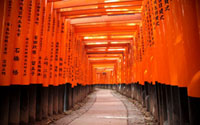
Fushimi Inari-taisha
Fushimi Inari Shrine or the Kyoto Fox Shrine (伏見稲荷大社, Fushimi Inari Taisha) is an important Shinto shrine in southern Kyoto. Some ten thousand torii gates line the walkways of Fushimi Inari Taisha and serve as its most charming and outstanding feature. Another popular point of this shrine is the numerous statues of kitsune, foxes who are thought to serve as the messengers of the god of agriculture and business, Inari. The trails lead into the wooded forest of the sacred Mount Inari, which stands at 233 meters and belongs to the shrine grounds. Each of the famous torii shrine gates has been donated by an individual or a Japanese business in the hope of receiving good luck and fortune. The name of the donor is inscribed in black ink on the back of each gate.
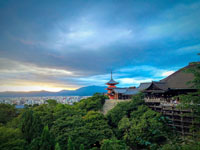
Kiyomizu-dera
Situated in the eastern Higashiyama area, Kiyomizu-dera (清水寺, literally "Pure Water Temple") is one of the most famous and celebrated temples in Kyoto. The temple was founded in 778 AD and contains buildings from the 17th century, including a main hall designated as a National Treasure. The temple’s wooden stage is undoubtedly what the temple is most famous for, offering an outstanding panoramic view of Kyoto rising out of a sea of maples. Drink the sacred water filled with good karma at the Otowa no Taki waterfall, wish for a loving relationship at the Jishu Shrine, venture into the “womb of the bodhisattva” tunnel and admire the numerous examples of beautiful architecture.
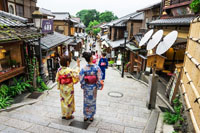
Gion District
Gion (祇園) is Kyoto's most famous geisha district, located around Shijo Avenue between Yasaka Shrine in the east and the Kamo River in the west. It is filled with shops, restaurants and ochaya (teahouses), where geiko (Kyoto dialect for geisha) and maiko (geiko apprentices) entertain. Gion attracts tourists with its high concentration of traditional wooden machiya merchant houses. Due to the fact that property taxes were formerly based upon street frontage, the houses were built with narrow facades only five to six meters wide, but extend up to twenty meters in from the street.
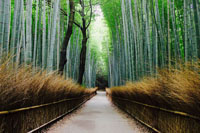
Arashiyama
A sprawling area in western Kyoto centered around the Katsura River and surrounding mountains, Arashiyama (嵐山) is an extremely popular tourist spot visitors to Kyoto won’t want to miss. Any given day you’re likely to see people in kimono or yukata enjoying local food, shopping, and pilgrimages to the local temples. Rickshaw drivers wait to carry you to your destination, whether it be the natural beauty of the bamboo forest or the man-made temples that have stood in Arashiyama for hundreds of years. Located on Mt. Iwata in Arashiyama, the Iwatayama Monkey Park is home to a 130+ strong troupe of Japanese macaque monkeys. Though the monkeys are wild and live on the mountain, the research center/park is a place where tourists can observe and feed the monkeys from an enclosed hut.
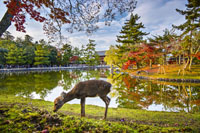
Nara
Japan's first permanent capital was established in the year 710 at Heijo, the city now known as Nara (奈良). Before that date, the capital used to be moved to a new location whenever a new emperor ascended to the throne. However, as the influence and political ambitions of the city's powerful Buddhist monasteries grew to become a serious threat to the government, the capital was moved away from Nara to Nagaoka in 784 and a few years later to Kyoto. Nara Park (奈良公園, Nara Kōen) is a large park in central Nara. Established in 1880, it is the location of many of Nara's main attractions including Todaiji, Kasuga Taisha, Kofukuji and the Nara National Museum. It is also home to hundreds of freely roaming deer.
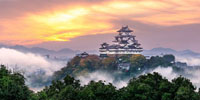
Himeji
Himeji Castle (姫路城, Himejijō), also known as White Heron Castle (Shirasagijo) due to its elegant, white appearance, is widely considered as Japan's most spectacular castle for its imposing size and beauty and its well preserved, complex castle grounds. The castle is both a national treasure and a world heritage site. Unlike many other Japanese castles, it was never destroyed by war, earthquake or fire and survives to this day as one of the country's twelve original castles. Kokoen (好古園, Kōkoen) is a relatively recently constructed Japanese style garden, which was opened in 1992 on the former site of the feudal lord's west residence (Nishi-Oyashiki). It consists of nine separate, walled gardens designed in various styles of the Edo Period. Mount Shosha (書写山, Shoshazan) is the site of Engyoji (円教寺, Engyōji), an atmospheric temple complex with a history of over 1000 years.
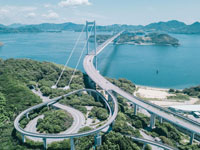
Shimanami Kaido
The Shimanami Kaido (しまなみ海道, Shimanami Kaidō) is a 60 kilometer long toll road that connects Japan's main island of Honshu to the island of Shikoku, passing over six small islands in the Seto Inland Sea. Our leisurely bike ride will take us to the observatory park is located at the top of Mt. Kiro at the southernmost point of Oshima Island. The view from here is known as the most spectacular on the Shimanami Kaido. Another stop is the Oyamazumi Shrine (大山祇神社 Oyamazumi Jinja) is located on the island of Omishima in the Seto Inland Sea. The shrine is dedicated to the gods who protect sailors and soldiers. Because of this, many daimyos and other military leaders have made offerings at the shrine in hopes of military success, or in thanks for victory in battle.
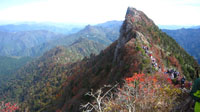
Mt. Ishizuchi
Mt. Ishizuchi (石鎚山, Ishizuchi-san) is one of the seven sacred peaks of Japan. The mountain consists of peaks including Tengudake, the highest point in western Japan, Misen, the location of the Ishizuchi Shrine, as well as a number of additional peaks to the south. A variety of walking trails are available including a 4.6km ridge walk from Tsuchigoya, Kumakogen-cho, or a cable car ride from Saijo-shi. There is also a challenging one-of-a-kind trail where climbers ascend a series of sheer cliffs by a network of chains. Never fear, for those without the strength for that a detour is available and there are plenty of options for visitors to take a trail suiting their fitness and experience. Upon reaching the summit the sense of achievement is beyond words. Majestic views stretching from the Seto Inland Sea and Tosa Bay to the Chugoku and Shikoku Mountains visible in the distance on fine days are magnificent!
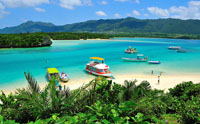
Ishigaki Island
Okinawa is the best known beach resort destination in Japan, and it is becoming trendy gradually to travel to remote islands accessible from the Okinawa’s main island. There are tens of remote islands in Okinawa recommended to spend your vacation and each island has unique attraction. Ishigaki Island (石垣島), the third largest island in Okinawa, is one of the most popular remote islands. Ishigaki offers several nice beaches and good snorkeling and diving in the surrounding coral reefs. Snorkeling can be enjoyed at nearly every beach on the island, while diving is offered through the numerous dive shops with tours available for all experience levels. If diving, be sure to check out the island's famed manta rays which congregate in large numbers around Manta Scramble near Kabira Bay.
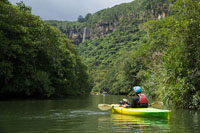
Iriomote Island
Iriomote Island (西表島, Iriomotejima) is Okinawa's second largest island. It is largely undeveloped, with nearly 90 percent of its land covered by dense jungle and mangrove forests. Wide areas of the island are part of the Iriomote Ishigaki National Park, the southernmost of Japan's national parks and one of the country's most unique. On this day trip from Ishigaki Island, you'll get to kayak through unspoiled mangrove on the Mare and Hinai rivers and hike to the base and top of Pinaisara Falls, where you'll be rewarded by a fantastic view of the island, and of the Hatoma, Barasu, and Hatobanare islands out to sea.
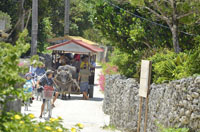
Taketomi Island
Taketomi Island (竹富島, Taketomijima) is an island just off the coast of Ishigaki Island and the site of a beautifully preserved, traditional Ryukyu village. As Taketomi Island is fairly small, it is often visited as a day trip from Ishigaki. Thanks to preservation efforts, the small village consists almost entirely of traditional style, one-storied houses, which are surrounded by stone walls, and covered with red tiled roofs and ample lion-like shisa statues to ward of evil spirits. Some of the village's houses serve as minshuku accommodations. Other traditional homes inside the village are used as restaurants and shops selling local food and crafts. There are no rental cars on Taketomi, and most visitors either walk or rent a bicycle to travel through the village's white sand roads and to the nearby beaches along the western shore of the island.
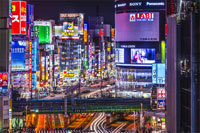
Shinjuku
Shinjuku (新宿) is one of the 23 city wards of Tokyo, but the name commonly refers to just the large entertainment, business and shopping area around Shinjuku Station. West of the station is Shinjuku's skyscraper district, home to many of Tokyo's tallest buildings, including several premier hotels and the twin towers of the Metropolitan Government Office, whose observation decks are open to the public for free. Northeast of the station lies Kabukicho, Japan's largest and wildest red light district, while department stores, subterranean malls and electronic shops surround Shinjuku Station on all four sides, including the redeveloped Southern Terrace.
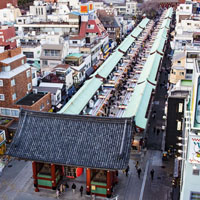
Asakusa
Asakusa (浅草) is the center of Tokyo's shitamachi (literally "low city"), one of Tokyo's districts, where an atmosphere of the Tokyo of past decades survives. Approaching the figure of the scene, a hulking gate adorned with a giant red lantern daubed with large kanji characters as traditionally dressed. While it may seem like a stage setting from a time gone by, this is the backdrop awaiting your camera lens at Asakusa’s largest temple, Sensoji and around. Step through Kaminarimon—the Thunder Gate—and wander through lively and extensive Nakamise shopping street, stopping off to pick up some authentic souvenirs on your way to the temple’s striking main hall. Tradition continues outside the temple grounds.
Asakusa is a town of water. It sits on the mighty Sumida River, and many landmark buildings line the banks. Head to the striking red Azuma-bashi Bridge for views of towering TOKYO SKYTREE and brews at the Asahi Beer Hall inside the Asahi Group Headquarter Building with its Philippe Starck-designed golden sculpture adorning the roof. For a taste of the city from the water, board the uniquely sculpted Hotaluna waterbus—from the creative mind of Japanese cartoonist Leiji Matsumoto—for a cruise up the river. The pier is located close to Asakusa Station, and it is possible to take trips to Hinode Pier, Odaiba Marine Park, the Hama-rikyu Gardens and Toyosu.
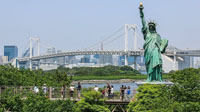
Odaiba
Odaiba (お台場) is a popular shopping and entertainment district on a man made island in Tokyo Bay. With all its technology centers, shopping malls and array of entertainment options, Odaiba may sound much like Shinjuku, Shibuya or any of Tokyo's other neon-lit core districts, but its singular seaside location gives it a much more relaxed holiday vibe. The spectacular Rainbow Bridge, the amazing Gundam Statue and Statue of Liberty, the worldwide famous Fuji TV Building, MIRAIKAN - he Museum of Science and Innovation, and many other exciting facilities are what draws thousands of visitors to Odaiba every day. If you're in need of some hot spring revitalization, for example, head for Oedo Onsen Monogatari, home to a wide range of baths and spas all housed within traditional Japanese-style buildings.
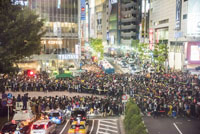
Shibuya
Shibuya (渋谷) is one of the twenty-three city wards of Tokyo, but often refers to just the popular shopping and entertainment area found around Shibuya Station. In this regard, Shibuya is one of Tokyo's most colorful and busy districts, packed with shopping, dining and nightclubs serving swarms of visitors that come to the district everyday. Shibuya is a center for youth fashion and culture, and its streets are the birthplace to many of Japan's fashion and entertainment trends. A prominent landmark of Shibuya is the large intersection in front of the station's Hachiko Exit. The intersection is heavily decorated by neon advertisements and giant video screens and gets flooded by pedestrians each time the crossing light turns green, making it a popular photo spot.
(Breakfast, Lunch, Dinner included)
Day 1 - Saturday, October 17, 2020:
Travel day
Day 2 - Sunday, October 18, 2020: (B)
Check into Kyoto Hotel
Day 3 - Monday, October 19, 2020: (B)
Visit Fushimi Inari-taisha, Yoshiki-en Garden, Nara Park, Todai-ji and Daibutsuden, Todaiji Nigatsudo
Day 4 - Tuesday, October 20, 2020: (B)
Visit Himeji Castle, Koko-en Garden, Mount Shosha
Day 5 - Wednesday, October 21, 2020: (B)
Visit Kiyomizu-dera, Otowa Waterfall, Ninenzaka and Sannenzaka, Gion District, Nishiki Market
Day 6 - Thursday, October 22, 2020: (B)
Check out of Kyoto hotel. Visit Arashiyama Bamboo Grove, Tenryuji Temple, Monkey Park Iwatayama, Togetsukyo Bridge & Sagano Shopping, Kimono Forest, Transfer to Matsuyama and check into hotel
Day 7 - Friday, October 23, 2020: (B)
Shimanami Kaido Cycling - Kirosan Observatory Park, Hirakiyama Park, Oyamazumi-jinja Shrine
Day 8 - Saturday, October 24, 2020: (B, L)
Hike Mt Ishizuchi
Day 9 - Sunday, October 25, 2020: (B)
Check out of hotel. Transfer to Matsuyama Airport for flight to Ishigaki Island
Day 10 - Monday, October 26, 2020: (B)
Visit Kabira Bay, Yonehara Beach, Mount Nozoko Ma-pe, Tamatorizaki Observation Platform
Day 11 - Tuesday, October 27, 2020: (B, L)
Iriomote Island - Kayak mangrove and waterfall hike
Day 12 - Wednesday, October 28, 2020: (B)
Taketomi Island - snorkeling tour and rent bicyle and explore the island
Day 13 - Thursday, October 29, 2020: (B)
Check out of hotel. Transfer to Ishigaki Airport for flight to Tokyo. Check into hotel. Explore Shinjuku in the evening.
Day 14 - Friday, October 30, 2020: (B)
Visit Tokyo Skytree, Asakusa, River Cruise from Asakusa to Odaiba, Odaiba Ōedo-onsen-monogatari
Day 15 - Saturday, October 31, 2020: (B)
Visit Meiji Shrine, Takeshita-dori, Shibuya
Day 16 - Sunday, November 1, 2020: (B)
Check out of hotel. On your own until evening flight back home.
From tracking the international flights from LAX to Tokyo/Osaka in October over the last few months, I have seen it fluctuate between $550 and $950. The best way to get the best deals is to set up price alerts. I would suggest going to www.SkyScanner.com and look for a roundtrip flight from Los Angeles (LAX) or wherever you are coming from to Tokyo (HND) - there are two airports in Tokyo but HND is closer to the city. Keep in mind that the beginning of the trip takes place in Kyoto and ends in Tokyo. Unfortunately, you can't create alerts for multi-city on www.SkyScanner.com but you can do it on Google Flights (www.google.com/flights). Usually, the price from LAX to HND is similar to LAX to Osaka. After you search for the roundtrip flight, create an alert for it.
When you get email alert for your flight, go to SkyScanner and change your search to a multi-city to find flights into Osaka. The best flights are from Japan Airline, ANA, American Airline. I would avoid the Chinese airlines because they are much longer. Please be aware that there are two main airports in Osaka - ITM and KIX. ITM is closer to Kyoto. After you land in Osaka, you'll need to transfer to Kyoto Station via limousine bus. From ITM to Kyoto Station, it will take 50 minute. From KIX to Kyoto Station, it will take 1hr 30min. My recommendation is to fly into ITM. Here are a few flights that might work for you.
For those who wants to fly into Japan early:
Depart LAX on Thursday, 10/15/2020, at 10:15am and arrives in ITM on Friday, 10/16/2020, at 5:35pm. There is a 2hr 10min layover in Haneda Aiport (HND)
Depart HND on Sunday, 11/1/2020, at 8:45pm and arrives in LAX on Sunday, 11/1/2020, at 1:45pm. This is nonstop flight.
For those who wants to fly into Japan on 10/18/2020:
Option 1:
Depart LAX on Saturday, 10/17/2020, at 10:15am and arrives in ITM on Sunday, 10/18/2020, at 5:35pm. There is a 2hr 10min layover in Haneda Aiport (HND)
Depart HND on Sunday, 11/1/2020, at 8:45pm and arrives in LAX on Sunday, 11/1/2020, at 1:45pm. This is nonstop flight.
Option 2:
Depart LAX on Saturday, 10/17/2020, at 12:55am and arrives in ITM on Sunday, 10/18/2020, at 7:35am. There is a 1hr 45min layover in Haneda Aiport (HND)
Depart HND on Sunday, 11/1/2020, at 8:45pm and arrives in LAX on Sunday, 11/1/2020, at 1:45pm. This is nonstop flight.
Option 3: (only if flights into HND are much cheaper than ITM)
Depart LAX on Saturday, 10/17/2020, at 12:55am and arrives in HND on Sunday, 10/18/2020, at 4:45am. As part of the trip, you'll get the 7 day JR Rail Pass, which will be activated on 10/18/2020. With the pass, you can take the bullet train from Tokyo to Kyoto Station in about 3 hours.
Depart HND on Sunday, 11/1/2020, at 8:45pm and arrives in LAX on Sunday, 11/1/2020, at 1:45pm. This is nonstop flight.
Please be aware that the hotel check-in 2:00pm. If you arrive early on 10/18/2020, you can drop off your luggage at the hotel and come back later to check-in.
Group booking are generally more than individual booking by a few hundred dollars. So it is best to buy the flight on your own. Having said that, we can try to arrange a group flight. Please let me know your preference on the departure date from LAX.
There is no deposit for this trip. Full payment is due by July 17, 2020.
Cancellation charges reflect the many expenses Friendly Adventures cannot recover if you cancel, even if you must do so due to illness, injury, or personal emergencies. These fees are not meant to be punitive in any way. The charges made reflect the expenses Friendly Adventures has incurred in administering your reservation and planning for your participation. We recognize that the majority of those who cancel their reservations do so out of necessity. Please note that we do not make any refunds for any unused portion of your trip, not arriving, arriving late, or leaving the trip early.
In the unfortunate event that you must cancel your trip, your land package refund will be determined according to the formula below.
Days prior to departure:
90+ days: Full refund
90 - 61 days: 50% of your land package fee payment
60 days or less: No refund
Friendly Adventures reserves the right to cancel or alter a trip due to unforeseen weather, unsafe conditions, low registrations or other circumstances. On the rare occasion when Friendly Adventures must cancel a trip, all payments received to date will be refunded, including the non-refundable portion of your deposit. Friendly Adventures is not responsible for expenses incurred in preparation for any canceled trips, including airplane tickets.
WE STRONGLY RECOMMEND TRIP CANCELLATION/TRIP INTERRUPTION INSURANCE, WHICH COVERS YOUR COST IF YOU NEED TO CANCEL OR INTERRUPT YOUR TRIP for medical reasons, trip delay, lost baggage, and other unforeseen emergencies. Friendly Adventures will send you information about travel insurance with your registration information, or you may purchase coverage through your own insurance company. In order to avoid disappointment and expense in the event that you must cancel your trip we strongly urge you to purchase some type of insurance coverage.
|
|
Make Reservation
Land package: $3,250
Departing from LAX Airport
Trip Includes
14 nights accommodation with breakfast; domestic flights from Matsuyama to Ishigaki and Ishigaki to Tokyo; ground/water transportation (public/private), which includes 7 days JR Rail Pass, Ishigaki 5 day bus pass and Tokyo 72 hours subway pass; entrance fee to various castles, temples and gardens; Mt Shosha and Mt Ishizuchi ropeways; Shimanami Kaido and Taketomi bike rental; Iriomote kayaking/waterfall tour; Ishigaki snorkeling tour; Tokyo Skytree admission; river cruise from Asakusa to Odaiba; entrance fee to Odaiba Ōedo-onsen-monogatari
Have a Question?
Send an e-mail to the organizers.
Trent Nguyen
Main Coordinator
John Corcoran
Assistant Coordinator
Ron Domash
Assistant Coordinator
|